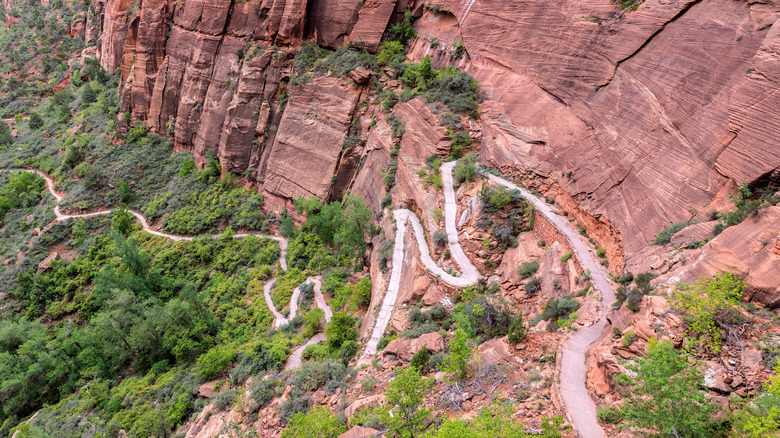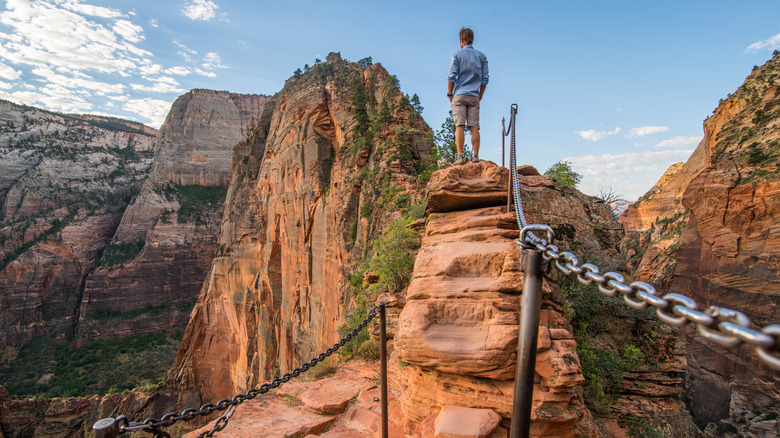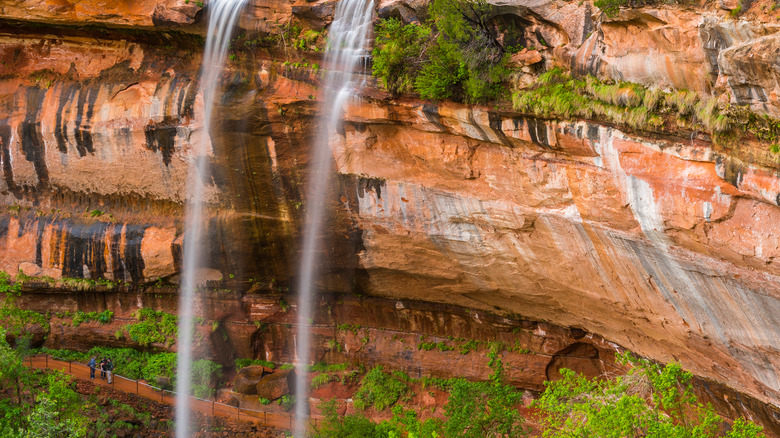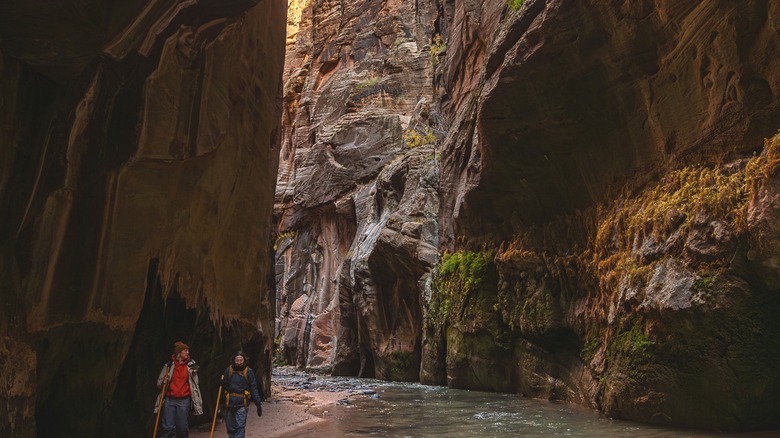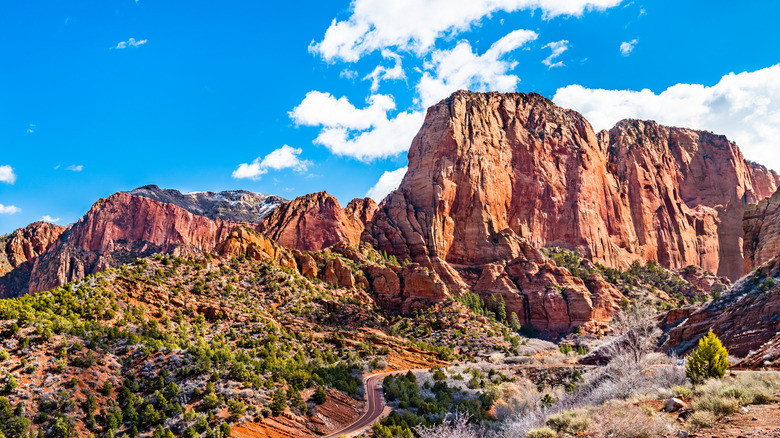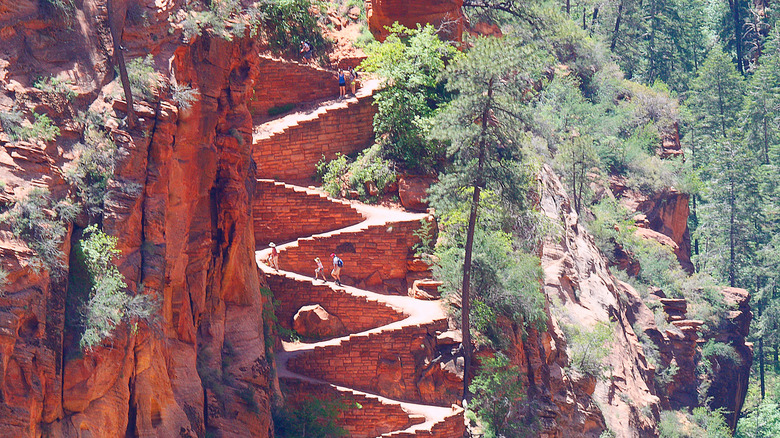Destinations In This Popular National Park You May Not Want To Take A Selfie At
Utah's Zion National Park is best known for its staggeringly big canyon. Unsurprisingly, those hiking up and down the sheer cliffs will want to take photos of the incredible views 2,000 feet above the ground. For some, grabbing a selfie in a precarious position can be a great way to show off their achievement to their friends — but unfortunately taking selfies in already risky situations can have devastating consequences. Even though it seems like no big deal to snap a quick picture, a 2018 study published in the Journal of Family Medicine and Primary Care found that 259 people around the world had died between 2011 and 2017 while trying to take a selfie. Since many of these deaths don't occur in front of others, there likely were many more that went unreported.
To try to keep people safe, national parks in India have banned selfies in certain areas where stopping for a photo would be dangerous and will fine anyone caught violating the ban. While national parks in the United States haven't done this yet, there have been instances of people dying while trying to get a good photograph of themselves. Zion National Park is a fantastic place to go explore — but in some of the more challenging areas, you may want to skip the selfie.
Angel's Landing
The Angel's Landing trail is known as one of the most dangerous hiking trails in the world, and the toughest part is the final half mile. There, hikers must negotiate their way along a narrow trail with sheer cliffs on either side. There is a chain running along this section of the trail so that people have something to hold on to, but many have still fallen to their deaths on this treacherous trail.
While it makes sense that those bold enough to attempt this terrifying part of the trip to the summit would want to take a photo to remember the exhilarating experience, it's definitely not worth it to let go of the chain to take a selfie. Instead, you should probably wait until you actually get to the top where there's more space and the views are even more spectacular — as long as you don't get too close to the edge.
Emerald Pools
The Emerald Pools trail is one of the most popular in Zion National Park because it is exceptionally beautiful and not considered particularly difficult. Those who hike this short trail are able to follow the course of a stream down from the cliffs above, through the canyon, and into the woods below. While there's nothing wrong with snapping a few pictures of you and your friends hiking the trail, you may want to proceed with caution when framing up a selfie — particularly when exploring Upper Emerald Pools, the highest part of the trail.
Although this trail is not usually thought of as being one of Zion's most dangerous, people have been killed hiking it. The trail's main attraction is the gorgeous flowing water, but the damp environment is perfect for algae, which can grow on the rocks on the trail and make it extremely slippery. Taking your eyes off of your hiking boots to look at your phone screen could make you more likely to accidentally step on algae and lose your footing — which can be deadly when too close to the cliff's edge.
The Narrows
One of the most interesting and unique natural settings in Zion National Park are known as slot canyons: skinny gorges where two sheer cliff walls leave only a small passage. Walking through these natural corridors is a wonderful experience, and can definitely make for a great photo opportunity, but you should be especially careful if you decide to stop for a selfie in Zion's most popular slot canyon, The Narrows.
Virgin River flows through the slot canyon, which means that those walking through the Narrows have to splash through the water. For many, that's part of the fun. Towards the beginning of the lower narrows this is relatively easy and safe, though there is always a risk of losing your footing on the rocks. Later on, however, those who brave this route often have to swim. On top of that, flash floods can occur, often causing The Narrows to be closed. The National Park Service tells visitors to check the forecast in advance and not enter the narrows if there is any risk of flash flooding predicted — but it's still a good idea to keep your eyes on the weather and your mind on the hike rather than on getting the perfect shot when you're in the water.
Kolob Canyon
Kolob Canyon is an exciting place to visit in Zion National Park, but in order to start your adventure down into the canyon, you'll need a permit. The reason is simple: it can be a dangerous proposition, and people have died trying to do it. It requires rapelling yourself down the steep cliff face with a rope to reach different levels, and because Kolob Creek rushes in the same direction, anyone attempting it will be in water for almost the entire time. This is why people love Kolob Canyon. It is challenging and provides the opportunity to see the beautiful landscape created by the creek. It's a thrilling adventure that requires skill, effort, and concentration. For a lot of the journey, breaking your concentration to take a photo is a bad idea.
On different occasions, people have died in Kolob Canyon from falling from cliffs and drowning in the water. While selfies were not to blame in these circumstances, drowning and falls have both been identified as major risks in selfie-related deaths. If there's any doubt when dealing with water and high places, it's better to wait for a safer spot to take a selfie.
Walter's Wiggles to Scout Lookout
The chain section of the Angel's Landing trail is the most infamously dangerous part of the trail, but that doesn't mean the rest is easy. While you're steeling yourself for the last heart-stopping half mile to the top, you may want to reconsider taking that nervous selfie. While it may not be as frightening, the earlier section of the trail known as Walter's Wiggles can be grueling and still requires concentration.
In order to help hikers get up the sheer cliffside, a series of switchbacks, or sections that wind sharply back and forth, were cut into the rock. While the result keeps visitors from having to scale straight up vertically, this part of the journey is tough. At this height, falling would certainly be extremely dangerous. While people have survived falling 250 feet from Scout's Lookout, that's not a risk anyone shold take for a photo. If you're not 100% certain that you're nowhere near the edge, skip the selfie.
